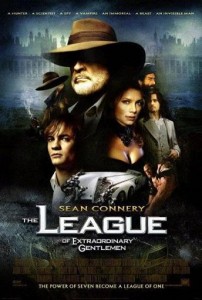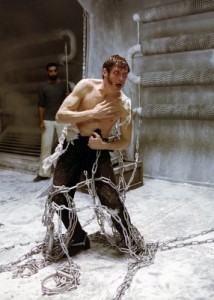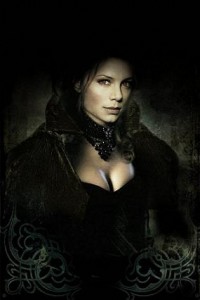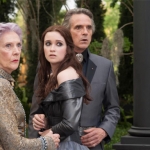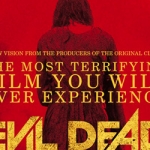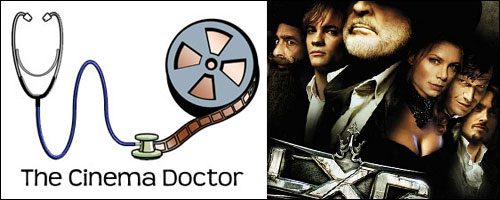
A few weeks back you stood in awe as The Cinema Doctor examined the ailing Aeon Flux. Now he’s back with a far more difficult case. This time he dares to stare into the terrifying faces of 20th Century Fox, Sean Connery, and Alan Moore as The Cinema Doctor examines his latest patient.
TODAY’S PATIENT:
The League of Extraordinary Gentlemen
Directed by Stephen Norrington
Starring: Sean Connery, Peta Wilson, Shane West, Stuart Townsend, Jason Flemyng, Naseerudin Shah, Tony Curran, and Richard Roxburgh
Based on the graphic novel series by Alan Moore and Kevin O’Neill
PATIENT DESCRIPTION: In the closing years of the 19th century, a masked terrorist known only as “The Fantom” is causing chaos throughout Europe, potentially leading Europe into a full scale war. The British Government decides to recruit a league of exceptional people to stop The Fantom. It just so happens these people are Allan Quatermain, Mina Harker, Tom Sawyer, Dorian Gray, Captain Nemo, The Invisible Man, Dr. Henry Jekyll, and Mr. Edward Hyde.
EXAMINATION:
HEALTHY ASPECTS:
- The film is very strong, aesthetically speaking. The production design is clearly drawing from steampunk influences, which lend a lot to the tone of the story and the world that the film is trying to create.
- For a novice, Norrington actually handles the cinematography very smoothly, making the action sequences smooth, lush, and energetic.
- Some of the casting choices are clever and even unconventional. Namely, Wilson, Flemyng, and Roxburgh.
- The visual effects are quite polished and accomplish what they set out to do. The most exceptional feats are all the effects surrounding The Invisible Man and Mr. Hyde.
- The inclusion of Dorian Gray is a nice addition and gives something new to the fans of the original graphic novel.
- Though it is disappointing that they don’t use the character of Hawley Griffin (aka, The ORIGINAL Invisible Man), the new character, Rodney Skinner, makes for a welcome source of humor, which never feels out of place.
- The concept of this film is so intriguing that it provokes people to want to read the original graphic novel series.
EARLY ASSESSMENT: LXG displays much potential on the technical side. It proves that a solid adaptation of Alan Moore’s singular adventure series is not impossible on that front. Director Stephen Norrington is an ideal director for the job. His previous outing with Blade shows that he has is quite adept at action on a fantastical level. You’ll find that it has a good escapist spirit to it–a spirit that in many respects embraces the period it’s set in. It also tries to not be a slave to the source material while attempting to show fidelity to it. However…
SYMPTOMS:
- An attempt to be faithful is only that, an attempt. You get the feeling that the director and the screenwriter were so intimidated by the higher ups at 20th Century FOX that they acquiesced to whatever the studio demanded, and as a result, compromised the true integrity of the project.
- The downside to this film making us want to read the original graphic novels is that after we read them we’ll never want to see the movie again.
- Though the inclusion of Dorian Gray was a clever idea, the character itself is so full of himself and so unlikeable that he practically screams out “traitor.” Though the movie attempts to divert your attention to The Invisible Man as the traitor, the execution is so hamfisted that the attempted sleight of hand never works.
- There is more character development in me typing “character development” right now than there is in the entire movie! What little development there is in the film is devoted entirely to the Allan Quatermain character. The main reason it is entirely devoted to that character is because Sean Connery executive produced this film, and because Sean Connery has so much clout, he was able to get what he wanted. What Connery clearly didn’t understand is that The League of Extraordinary Gentlemen is meant to be an ensemble piece. It isn’t just one main character and his right hand men. It’s supposed to be about a group of unconventional people who are forced to ascend beyond their personal vices, grievances, and conflicts, all for the greater good.
- The studios and the screenwriter also seem to have no respect whatsoever the the original literary classics from which the main characters are derived. It’s practically to the point that it ruins the characters utterly. Here are some examples:
- Mina Harker never succumbed to Dracula to the point where she herself actually became a vampire. To portray her as a vampire in the film makes Mina look weak and susceptible to seduction (Which seeing how she fell for Dorian Gray in lieu of her better judgment punctuates that point). In the end we’re left scratching our heads as to why a fully developed vampire can walk in the sunlight.
- The powers-that-be clearly didn’t understand the true nature of the inner conflict of Dr. Jekyll and Mr. Hyde. In the original story, Dr. Jekyll only has to drink the formula once. The whole purpose of the formula is to separate the evil side and good side within one man and subsequently dispose of the evil. Jekyll created it to cure homicidal maniacs of their murderous tendencies. Due to the fact that his peers refuse to allow human experimentation, Jekyll is forced to experiment on himself. Unfortunately this begins Jekyll’s inner conflict with Hyde. Jekyll is a noble man of science who seeks to do good in his experiments. Mr. Hyde is the product of his inhibitions being removed and ultimately releasing a violent, lecherous beast upon London. Alan Moore understood this. In the graphic novels, Jekyll is a quivering, pathetic, wreck when we find him in Paris. This is because more and more he is succumbing to Hyde’s animalistic urges. Inevitably, thanks to Mina, the conflict ends when Hyde finds something he actually cares about and finds himself willing to die for that something.
- In relation to the nature of Jekyll’s formula, the studios clearly sacrificed essential plot details in favor of a CGI fight sequence, because the film has one of The Fantom’s henchmen drinking a massive dose of the formula to fight Hyde. It’s clear that the studios didn’t really care. If they did, they would know that if the evil henchman drank the formula, the real effect would have turned him into a puppy dog (figuratively speaking). The formula isn’t a super-steroid! If the studio really cared about this plot-hole, they could have easily written a line where Skinner reports that the villains pervert the formula to enhance the evil aspects of their henchmen.
- Granted, the studio couldn’t get the rights to the original character of Hawley Griffin (The Invisible Man). However, seeing that Alan Moore was able to get the rights despite the fact that the character isn’t public domain, you’d think the studio would be willing to shell out the dough to put him in the movie. Rodney Skinner is a great character, and in any other movie he would be most welcome, but if we really want to ponder the possibility that The Invisible Man could be a traitor, the character of Hawley Griffin is far more fitting, especially since his character betrays The League in volume 2. So throwing in a character whose treachery is more likely will provoke us to direct attention away from Dorian Gray.
- Though the production design is quite good, the design of Captain Nemo’s vessel The Nautilus is utterly atrocious and designed with evident disdain towards the original concept of Nemo’s magnificent submarine. In Jules Verne’s novel, the main characters pursue The Nautilus, believing it to be a vicious sea monster. Last I checked, sea monsters don’t look like swords.
- As with many sci-fi / fantasy flicks, it’s natural to employ a little bit of suspension of disbelief, but this film asks you to suspend common sense along with it. Never mind that we have a car chase in 1899, but to expect us to believe that we’re seeing a car chase in 1899 in VENICE, of all places, is absolutely ludicrous.
- Though many of the fight scenes are very well staged, all the fights featuring Sean Connery seem sluggish by comparison. Something tells me the old boy is finally feeling his age.
- The revelation of The Fantom’s true identity (James Moriarty) is totally underwhelming and redundant. The villain’s identity is only significant in the graphic novel because the League assumes that their superior M is Sherlock Holmes’ brother, Mycroft Holmes. Additionally they only assume it because they never see M. Their orders are given to them by Campion Bond.
- The inclusion of Tom Sawyer into the story is painfully weak, as is the reason the studio insisted on it. Contrary to the studio’s belief, American audiences will not feel alienated if all the main characters are not American. If we only want American heroes, why is James Bond so successful?
DIAGNOSIS: Studious Interferius with traces of Primadonus Actorus
With all the other successful comic book movies being made around this time, it is blatantly clear that 20th Century Fox was trying to reap another potential comic franchise on the side. Believing that they were invincible after the success of X-Men, the execs thought that they understood the anatomy of making another great comic movie, so they picked a novice director who appears to have been easily intimidated. The studio then muscled Norrington into casting Sean Connery, who went on record to say he only chose to do this because he missed out on the Matrix and Lord of the Rings. So Connery thought that executive producing this would guarantee him a new franchise to give his retirement fund a boost. As it turns out, Alan Moore’s material may be easy to create on the technical side, but the studios clearly didn’t appreciate that the story was far more complicated. I’m just thankful that this didn’t carry over into From Hell or V For Vendetta.
ADVISE TREATMENTS:
FOX’s track record has been extremely shoddy of late, largely owing to their inability to be a little more daring with their films. It’s common knowledge that the works of Alan Moore are less action extravaganzas and more like literature. It stands to reason that if you’re going to transfer any of his works to the screen, you should feel obligated to hand the project to a studio that can appreciate the intricacies of the inspiration. In any good adaptation, it’s essential that the producers, the screenwriter, and the director understand what makes their projects interesting. If they’re going to invest millions of dollars into producing it, they need to know what traits made this license so successful and how they can work to translate it to the screen. It’s also important to remember that the director rules the roost of a production, NOT the actors. Just because Sean Connery put some dough into the flick and just so happens to be a screen legend, it doesn’t mean he’s right about the way a film should be made. If any film is based on another source, it is absolutely critical that said source should be respected and embraced. After all if you’re not passionate about something, what’s the point of doing it?
PRESCRIPTION:
- Switch studios to one that actually has the courage to take a risk.
- Cast actors who are willing to respect the material and treat it as more than just a cash cow.
- Carefully dissect the material and the characters in order to flesh out the script more effectively.
- Replace Sean Connery with an actor with less studio clout. Possibly Roger Moore, Michael Gambon, or Pete Postlethwaite
- Strive to preserve the intent and integrity of both the graphic novel and the classic novels, which each of the main characters stem from.
- Ditch the Tom Sawyer character. We don’t need him and he ain’t welcome.
Can this patient be saved? Unless the patient is transferred to a better hospital, its chances are grim.


